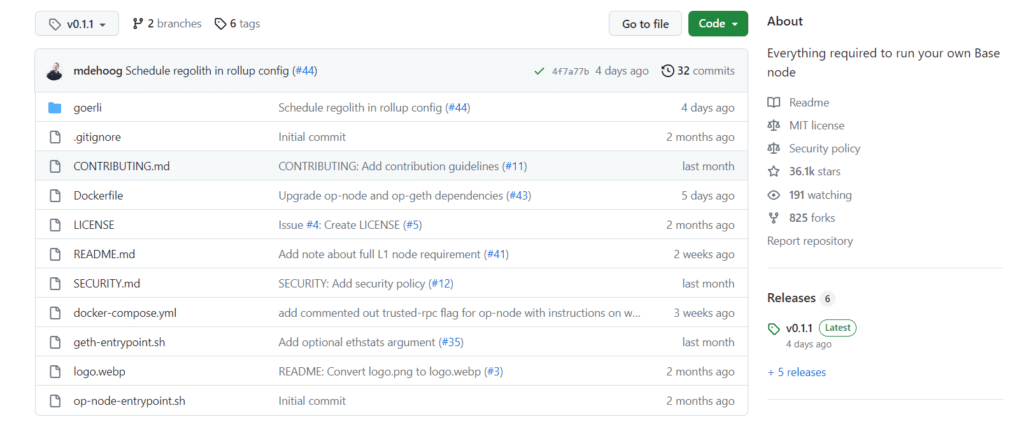Latest crypto market news: Base, an Ethereum blockchain scaling solution developed by Coinbase, has announced that Testnet Goerli will undergo the Regolith hard fork on 27 April at 5 PM (UTC).
The update comes on the heels of a recent change to the Optimism protocol, which increased network efficiency and improved node synchronization.
Let’s look together at the details of this hard fork
Summary
Coinbase follows Optimism crypto news: Base’s Regolith hard fork
The latest news in the crypto market tells us that Coinbase is preparing to launch its Layer 2 Base, an alternative substrate of the Ethereum blockchain that aims to increase the volume of transactions performed on the L1 by moving some of the computation work off-chain.
This type of blockchain scaling solution can boast of Ethereum’s security standard and the scalability and cost-effectiveness of operations guaranteed by integration with the OP Stack, a set of software that enables the development of “optimistic rollups” on Layer 2 networks.
Recently, Regolith was announced: the first hard fork of Base that will run on the Goerli testnet, a network that developers use for testing, pending the launch of the Mainnet.
The update, named after the hard fork of the same name carried out on Optimism nodes on 17 March, is being planned with the goal of making Base more secure and reliable.
This “Regolith hardfork” applies to nodes that use rollup technology to process transactions and execute smart contracts through so-called “zero-knowledge cryptographic proofs,” more specifically fraud proofs.
In concrete terms, changes will be made to the configuration of timestamp-based nodes and the OP stack execution engine.
In order to maintain synchronization, Base nodes will need to be updated to version v01.1.1, as there will be no blockchain downtime.
The end user should not be impacted at the experiential level during the tesnet upgrade periods.
To monitor the progress of work and the latest crypto news regarding Coinbase and this hard fork, you can visit this website, which reports on mishaps and scheduled maintenance on layer 2.

What is a hard fork and why should Base perform it?
A hard fork is an update to a protocol mechanism that forces all nodes to upgrade to the next version of the software in order to stay current and synchronized with all other nodes in the network.
The concept of a hard fork involves there being a split between two blockchains, the one prior to the upgrade and the one that has integrated the new software.
The community of the project in question can decide which side to be on, that is, whether to accept the upgrade and download the latest version or stay on the original blockchain.
Generally, this type of update is carried out when there is a major change from the point of view of node configuration or when there are hacks or serious problems that endanger the integrity of the network.
Throughout history, Ethereum has also faced several hard forks, most notably the one that divided the community following the DAO hack that took 3.6 million ETH from the project.
In that context, the choice to create a parallel sidechain and “pretend” that the hack never happened, resuming the transaction log from the moment before the theft, was made with the intention of not damaging the ecosystem and preserving the security of the blockchain.
The majority of developers in that case had decided to install the new version of the Ethereum software, which is the one we know today.
In the case of Coinbase’s Layer 2, the crypto news of the ‘hard fork’ does not stem from security issues or cyber attacks, but results at least “forced” after Optimism nodes implemented the Regolith update on 17 March, changing the structure and architecture of the Ethereum substrate.
Hence, it is an adjustment of the Base nodes, which have to synchronize with the improvements at the technical level that the Optimism team has implemented on its infrastructure, the way to make the flow of data and management of off-chain computation work more efficient.
We expect that almost all Base nodes will install the new software.
Coinbase and Optimism: the superchain concept
Coinbase’s crypto news of developing a transaction layer secondary to Ethereum is an important step in building a robust and interoperable Web3 ecosystem that can serve as a hub for upcoming decentralized applications and scaling solutions that will be developed in the coming years.
Soon, some 110 million users who are currently customers of the cryptocurrency exchange will be able to leverage this infrastructure to conduct transactions securely, with low fees, and in a trustless manner.
However, future developments of Base, will not be carried out autonomously by Coinbase but will be supported by the OP stack software set, so as to accelerate the transition to decentralization, which is the main feature of cryptocurrencies.
Specifically, the shared intent between the parties is to develop a superchain, in other words, an ecosystem made up of different layers that can amalgamate their wealth of experience and user base to create a cryptoeconomy that is functional to the needs of developers and capable of achieving mass adoption.
Base and Optimism Mainnet will both function as independent L2s in the short term, offering a suite of products to the Web3 community, such as swaps, loans, etc.
In the long term, it is expected that there will be use cases of implementations on Optimism Mainnet or Base, which will offer developers the flexibility that best fits their use case.
Meanwhile, a percentage of the fees earned through transactions on individual Layer 2s will be donated to the Optimism Collective, helping to fund the core public goods infrastructure of both the Superchain and the broader cryptoeconomy.
In order for the concepts of decentralization and financial freedom to reach a wide number of people, it is necessary to join forces in a way that simplifies and accelerates the transition of capital from the centralized economy to one rooted on blockchain technology.
In this sense, Coinbase’s notoriety and the reliability of its services combined with the technical background enjoyed by the Optimism team could soon result in the development of a scalable, secure and easily accessible Superchain for all.
Unity is strength.





